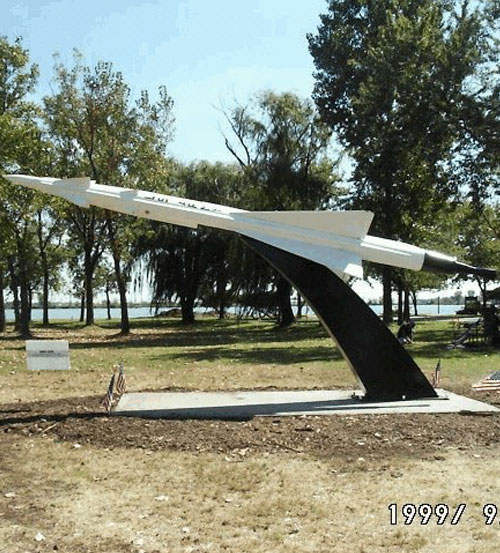Nike Ajax missile, dedicated in 1999, points in direction of launch site.
Photo by Rod Sellers

Nike Ajax missile, dedicated in 1999, points in direction of launch site.
Photo by Rod Sellers
En route to this site, note at 117th Street the building on left. Formerly Memorial Hall and home to Steel Workers Local 1033, it is dedicated to those who lost their lives in the labor protest on Memorial Day, 1937, at Republic Steel. It is now the Zone, a youth and community center operated by the East Side United Methodist Church. On the right side of Avenue O, about a quarter of a mile west, is the site of the massacre.
The Nike Ajax Missile was dedicated in September 1999 as part of a six-day, century-end celebration of the William Powers State Fish & Wildlife Area. George Sadowski, a Hegewisch funeral director, formed a group of veteran organizations and community residents that inquired about obtaining a Nike missile from a military museum near San Francisco. When told one was available, they sent a truck out to San Francisco to transport it Wolf Lake. Upon arrival, the missile was restored and repainted before being placed on a concrete platform. Note that the missile points toward the launch site.
The kiosk was donated by local attorney George Tamvakis for the 1999 rededication of the William Powers Conservation Area. It is maintained by the Illinois DNR.
The closed Nike Missile Launch Site served in the 1950-60s during the Cold War as a response in case of airborne attacks from Russia. The steel mills and refineries in the area were thought to be prime targets for a Russian air offensive. Missile launchers were constructed on the ground, then 10 feet of slag was dumped around and over the launch sites. It created a plateau that you see today.
Cook County owns the 44-acre site. It was constructed in 1956 and closed in 1963. The US Department of Defense transferred the property to the Forest Preserve District of Cook County in 1965. By the early 1970s, all buildings had been removed and the site leveled, but concrete pads remain. A preliminary assessment to identify all potentially contaminated areas was completed and corrected. The US Army Corps of Engineers began the study in March 2002 under oversight by the Illinois Environmental Protection Agency. It was completed several years later with a final cleanup.
In a survey by the Field Museum of Natural History, some 123 bird species, including migrant hummingbirds and songbirds, were found at the site.